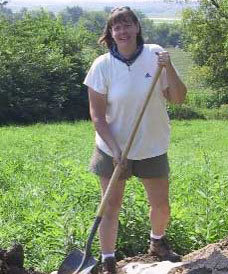
“What would your garbage tell us about you?” asks Indiana State Museum education program coordinator Gail Brown.
Five elementary schoolteachers from around the region sort through accumulations of trash—fast food wrappers, empty yogurt cartons, dog food cans—in a classroom in the University of Notre Dame Department of Anthropology’s Reyniers Laboratory on the north end of campus.
Dog food can—can we infer a pet owner?
It’s all part of Project Archaeology, a workshop cosponsored by the anthropology department and the museum.
Earlier this summer, the teachers spent three days on campus learning the fundamentals of archaeology. They participated in an archaeological dig on a property in the “Sorinsville” neighborhood south of campus, led by Deb Rotman, assistant professional specialist in anthropology. They then returned to the lab to process and analyze their finds.
The teachers also had time to try a few other activities, like throwing spears with an atlatl, an ancient tool that increases the range and velocity of a throw.
The goal of the program is to teach elementary educators how to use archaeology in the classroom. But the larger goal is to teach the public to respect, protect and conserve archaeological sites.
The way archaeology is done in real life isn’t like “Indiana Jones,” Brown said. “It’s not just collecting things; it’s about collecting data.”
Why a lesson on garbage? Archaeologists often study garbage heaps, or middens, he points out. It’s a way for kids to understand how objects relate to people and their activities—3,000-year-old objects kids wouldn’t know how to interpret, Brown says.
This fall, the teachers will incorporate what they learned in the workshop into their lesson plans. Their fourth-through seventh-grade students will use observation, inference and hypothesis to understand what garbage—or tools, or artifacts—can tell us about a culture.
In the process of learning archaeological methods, students also will be developing other skills—gridding a site requires math and measuring skills, tree-ring dating and pollen analysis offer hands-on science lessons and discussion about climate change.
“It’s been a good experience,” says Cindy Young, a teacher at Prairie Vista Elementary School in Granger. “I liked the field excavation with Deb, going out and actually doing what we were talking about. And I thought it was neat how many math, science and reading connections there were with archaeology.”
Observation and inference apply to many subjects, she notes.
“I’ve gotten a lot of stuff I can take back to the classroom,” she says. “Lessons and real-life experience.”
Originally published by at newsinfo.nd.edu on August 14, 2008.